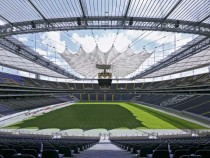
© Heiner Leiska
The past decade has witnessed the emergence of a new type of stadium that at first sight is reminiscent of familiar arenas from history; for example, the U-shaped stadium in Delphi (5th century BC); the amphitheatre in Epidaurus (4th century BC) with its steep tiers of seating; and, of course, the Colosseum in Rome (AD 70–80), which provided the model for many later arenas in Verona, Arles, Nîmes and elsewhere. The Colosseum, accommodating roughly 50,000 spectators, was the first important multifunctional stadium in history, the venue of gladiatorial fights and simu-lated sea battles. By means of a system of ropes, the arena could be covered with a canvas roof to provide protection against the weather. The three-tier layout and the staircase system allowed a quick exit. Whereas the citizens of ancient Rome had free access to events, however, sporting arenas today are subject to great economic pressures, resulting in extreme commercialization. Alongside the areas for spectators, therefore, sales spaces and conference facilities are provided.





